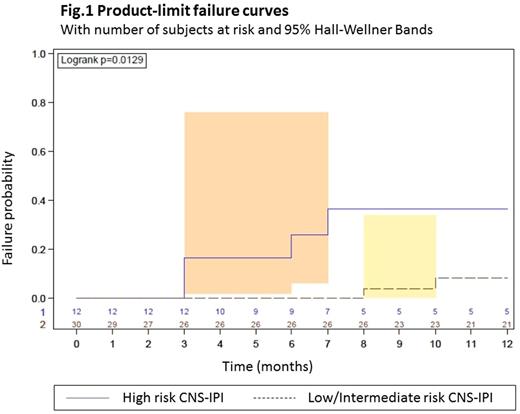Abstract

Background:
Central nervous system (CNS) relapse is an important and most often fatal event in patients (pts) affected by Diffuse Large B cell lymphoma (DLBCL). Identifying high risk pts is critical to guide diagnostic and therapeutic approach.
Recently, Schmitz et al. validated a risk score (CNS-IPI) that predicts the risk of CNS recurrence/progression in pts affected by DLBCL treated according to standard chemotherapy. It includes IPI score and kidney and/or adrenal glands involvement (scored 1 point if present or 0 if absent). Three levels of CNS recurrence/progression risk are defined: low (LR: 0-1 points), intermediate (IR: 2-3 points), high (HR: 4-6 points) showing significantly different rates of CNS disease at 2-years follow-up (0,6% for LR group, 3,4% for IR group, and 10.2% for HR group).
This score has been validated in HIV negative population. Since DLBCL are more aggressive and at higher risk of CNS relapse/progression in HIV positive (HIV+) pts, studies of the validity of CNS-IPI score in this setting are particularly needed.
The aim of our study was to evaluate the rate of CNS relapse in our HIV+ population as regard to CNS-IPI score. Furthermore, we evaluated if HIV-related parameters (such as CD4+ T cell count and HIV-RNA at lymphoma diagnosis) could influence the risk of CNS relapse.
Methods: Observational, multicenter, cohort study involving 6 centres in Lombardy, Italy. HIV+ pts with DLBCL diagnosis observed from 2009 to 2015 were included in this analysis. The CNS relapse risk was estimated for all pts based on the CNS-IPI score (LR, IR, HR). Continuous variables were described by median values and first and third quartiles. Chi-square or Fisher's exact test and Kruskal-Wallis test were used for comparison of discrete and continuous variables, respectively.
Results: Sixty-one HIV+ pts with DLBCL were included. General characteristics of population showed: 90% male; median age 49 years; median CD4+ T cell count at lymphoma diagnosis 224 cells/mm3; median HIV-RNA log10 4.2; 34% HCV Ab pos; 70.5% on antiretroviral treatment (ART) at the onset of DLBCL; 93.4% treated with R-CHOP like regimen and 6.6% pts with higher-intensity chemotherapeutic regimen; 54% with IPI ≥3 and 46% with IPI <3; 19.7% pts underwent intratechal (IT) prophylaxis. According to CNS-IPI score we defined 13 pts (21,3%) at HR of CNS relapse, 38 pts (62,3%) at IR and 10 pts (16,4%) at LR of CNS relapse. Pts belonging to HR group displayed significantly higher number of extranodal sites (84.6% showing 2-4 extranodal sites) as compared to IR and LR groups (20% and 0% showing 2-4 extranodal sites, respectively, p=0.03). In addition, pts with HR score showed a poor ECOG PS (61.5% showing >2) as compared to intermediate and low CNS relapse risk (20% and 20% showing ECOG PS >2, respectively, p=0.01).
In our series, we didn't find any significant association among HIV-related characteristics at lymphoma diagnosis (CD4+ T cell count, nadir CD4+ T cell count, HIV-RNA log10, use of ART) and CNS-IPI risk score. After a median follow-up of 28 months (range 4-96), 6 pts (9.8%) displayed a CNS relapse. We found that CNS relapse was significantly more frequent in CNS-IPI HR pts (4/13, 30.8%) as compared to CNS-IPI IR or LR pts (2/30, 6.7% and 0/10, 0%, respectively, p=0.049). No association was found between HIV-related characteristics and CNS relapse. The risk of death was also significantly higher in CNS-IPI HR group (69.2%) as compared to IR and LR groups (33.3% and 0%, respectively, p<0.0001). As shown in Figure 1, all CNS relapses occurred in the first 12 months after diagnosis. No association was found between IT prophylaxis and CNS relapse, even if very few pts underwent this procedure.
Discussion: In our study we found that CNS-IPI score could be considered as a valuable prognostic tool of CNS relapse/progression also in HIV+ pts. We found a higher rough proportion of DLBCL pts belonging to HR CNS-IPI group in our HIV+ cohort as compared to published data on general population, even if no relationship emerged between HIV-related parameters and CNS relapse risk. Further studies on larger HIV+ population are required to confirm the validity of this score; moreover, the integration of HIV-specific markers and histological characteristics of DLBCL could ameliorate the therapeutic approach and finally reduce the risk of CNS disease in HIV+ population.
Gambacorti-Passerini: Pfizer: Consultancy, Honoraria, Research Funding; BMS: Consultancy.
Author notes
Asterisk with author names denotes non-ASH members.

This icon denotes a clinically relevant abstract


This feature is available to Subscribers Only
Sign In or Create an Account Close Modal